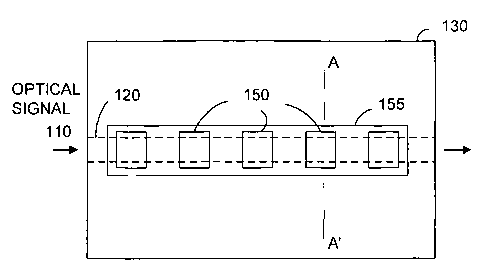Some of the information on this Web page has been provided by external sources. The Government of Canada is not responsible for the accuracy, reliability or currency of the information supplied by external sources. Users wishing to rely upon this information should consult directly with the source of the information. Content provided by external sources is not subject to official languages, privacy and accessibility requirements.
Any discrepancies in the text and image of the Claims and Abstract are due to differing posting times. Text of the Claims and Abstract are posted:
| (12) Patent Application: | (11) CA 2469824 |
|---|---|
| (54) English Title: | OPTICAL AMPLIFIER WITH TRANSVERSE PUMP |
| (54) French Title: | AMPLIFICATEUR OPTIQUE AVEC POMPE TRANSVERSALE |
| Status: | Deemed Abandoned and Beyond the Period of Reinstatement - Pending Response to Notice of Disregarded Communication |
| (51) International Patent Classification (IPC): |
|
|---|---|
| (72) Inventors : |
|
| (73) Owners : |
|
| (71) Applicants : |
|
| (74) Agent: | RICHES, MCKENZIE & HERBERT LLP |
| (74) Associate agent: | |
| (45) Issued: | |
| (86) PCT Filing Date: | 2002-11-22 |
| (87) Open to Public Inspection: | 2003-06-26 |
| Examination requested: | 2004-06-07 |
| Availability of licence: | N/A |
| Dedicated to the Public: | N/A |
| (25) Language of filing: | English |
| Patent Cooperation Treaty (PCT): | Yes |
|---|---|
| (86) PCT Filing Number: | PCT/US2002/037677 |
| (87) International Publication Number: | US2002037677 |
| (85) National Entry: | 2004-06-07 |
| (30) Application Priority Data: | ||||||
|---|---|---|---|---|---|---|
|
An optical amplifier comprises a device substrate, a first waveguide embedded
in the device substrate, and a plurality of lasers. The lasers are positioned
to provide a first plurality of light beams substantially transverse to the
first waveguide.
L'invention concerne un amplificateur optique qui comprend un substrat de dispositif, un premier guide d'ondes incorporé dans ce substrat de dispositif, et une pluralité de lasers. Ces lasers sont placés de façon à produire une première pluralité de faisceaux lumineux sensiblement transversaux par rapport au premier guide d'ondes.
Note: Claims are shown in the official language in which they were submitted.
Note: Descriptions are shown in the official language in which they were submitted.

2024-08-01:As part of the Next Generation Patents (NGP) transition, the Canadian Patents Database (CPD) now contains a more detailed Event History, which replicates the Event Log of our new back-office solution.
Please note that "Inactive:" events refers to events no longer in use in our new back-office solution.
For a clearer understanding of the status of the application/patent presented on this page, the site Disclaimer , as well as the definitions for Patent , Event History , Maintenance Fee and Payment History should be consulted.
| Description | Date |
|---|---|
| Time Limit for Reversal Expired | 2011-11-22 |
| Application Not Reinstated by Deadline | 2011-11-22 |
| Inactive: Abandoned - No reply to s.30(2) Rules requisition | 2011-02-02 |
| Deemed Abandoned - Failure to Respond to Maintenance Fee Notice | 2010-11-22 |
| Inactive: S.30(2) Rules - Examiner requisition | 2010-08-02 |
| Amendment Received - Voluntary Amendment | 2010-05-20 |
| Amendment Received - Voluntary Amendment | 2009-12-21 |
| Inactive: S.30(2) Rules - Examiner requisition | 2009-06-19 |
| Inactive: IPRP received | 2007-03-23 |
| Inactive: IPC from MCD | 2006-03-12 |
| Inactive: IPC from MCD | 2006-03-12 |
| Inactive: Cover page published | 2004-08-17 |
| Letter Sent | 2004-08-10 |
| Letter Sent | 2004-08-10 |
| Inactive: Acknowledgment of national entry - RFE | 2004-08-10 |
| Application Received - PCT | 2004-07-09 |
| National Entry Requirements Determined Compliant | 2004-06-07 |
| Request for Examination Requirements Determined Compliant | 2004-06-07 |
| All Requirements for Examination Determined Compliant | 2004-06-07 |
| National Entry Requirements Determined Compliant | 2004-06-07 |
| Application Published (Open to Public Inspection) | 2003-06-26 |
| Abandonment Date | Reason | Reinstatement Date |
|---|---|---|
| 2010-11-22 |
The last payment was received on 2009-11-03
Note : If the full payment has not been received on or before the date indicated, a further fee may be required which may be one of the following
Patent fees are adjusted on the 1st of January every year. The amounts above are the current amounts if received by December 31 of the current year.
Please refer to the CIPO
Patent Fees
web page to see all current fee amounts.
| Fee Type | Anniversary Year | Due Date | Paid Date |
|---|---|---|---|
| Basic national fee - standard | 2004-06-07 | ||
| MF (application, 2nd anniv.) - standard | 02 | 2004-11-22 | 2004-06-07 |
| Registration of a document | 2004-06-07 | ||
| Request for examination - standard | 2004-06-07 | ||
| MF (application, 3rd anniv.) - standard | 03 | 2005-11-22 | 2005-11-04 |
| MF (application, 4th anniv.) - standard | 04 | 2006-11-22 | 2006-11-02 |
| MF (application, 5th anniv.) - standard | 05 | 2007-11-22 | 2007-11-05 |
| MF (application, 6th anniv.) - standard | 06 | 2008-11-24 | 2008-11-07 |
| MF (application, 7th anniv.) - standard | 07 | 2009-11-23 | 2009-11-03 |
Note: Records showing the ownership history in alphabetical order.
| Current Owners on Record |
|---|
| INTEL CORPORATION |
| Past Owners on Record |
|---|
| ANDREW ALDUINO |
| CHRISTOPHER SCHOLZ |
| RONGCHUNG TYAN |